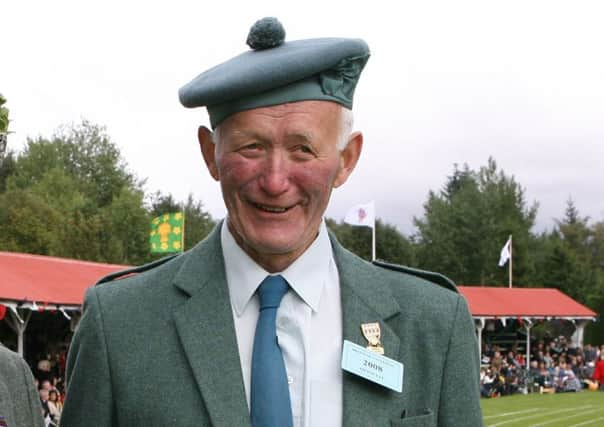Obituary: Sandy Gray, farmer and Highland Games legend


At 6ft 6in and 19 stones of almost pure muscle Sandy Gray could have been a seriously intimidating opponent – he had carried one of Deeside’s famous Dinnie Stones, hoisted an impossible dumbbell and won the Scottish Heavy Events championship.
But the affable athlete was not interested in gamesman or one-upmanship and had no real competitive streak: he was simply a farmer who participated in athletic events for which he rarely trained. And that was what made him one of the best-loved characters on the heavy circuit.
Advertisement
Hide AdAdvertisement
Hide AdHis formidable strength, which was never tested to the full, and mischievous, easy-going manner earned him the admiration of fellow athletes, audiences and royalty – the late Queen Mother and Duke of Edinburgh always looked out for him, acknowledging him with a wave as they left the Braemar Gathering, one of the events he had been associated with for 50 years, as a competitor and judge.
The roots of his success on the field could be traced back to his childhood when, with money in short supply, he, his brothers and other local youngsters threw weights around for fun. Born on the Craigievar Estate at East Eninteer, home of the Gray family for six generations, he was the third of five children to parents Jim and Isabella. Known as both Henry and Sandy, he was brought up on the 96-acre farm with his brother and sisters and two of his father’s four blind siblings.
Already a strapping lad by the time he attended Cushnie School, where in winter he used to pull numerous children on one sledge, he was more interested in the farm than lessons and left aged 14 to work the land with his father and brother. He won his first competition prize four years later, at the annual Craigievar Estate picnic, when he entered the hammer throwing contest.
Then in 1949, while competing in the heavy events at the nearby Tarland Show, he was spotted by Lady MacRobert of Douneside, who was also patron of the Aboyne Games. She inquired if he was to compete at the upcoming event and, after discovering he did not own a kilt, paid for him to have one made. Unfortunately his performance at Aboyne was disappointing – he failed to win a thing – but encouraged by an old hand among the heavies, George Clark, he began to improve.
He went on to break Clark’s long-standing heavy hammer record at Aboyne first by 13 inches and then by 16in, taking it to 96ft 8in. He also broke Clark’s Braemar heavy hammer record with a throw of 98ft and ½in.
In 1953 Gray, who had a palm-span of four-and-a-half inches and was reputed to have the strongest grip in Europe, pulled off another amazing feat of strength by lifting one of the Dinnie Stones. Weighing more than 300lbs, the stone was one of two giant granite boulders carried across Deeside’s Potarch Bridge and back by 19th-century strongman Donald Dinnie.
The challenge for Gray, during a contest in Aberdeen’s Music Hall, was to lift one, with one hand, 20 yards across the stage for a £20 prize. He managed 18 yards with the stone – others struggled to manage a “mere” four or five yards, while some could not lift it at all – and was deemed to have failed. But a raucous crowd disagreed and the cash was eventually handed over.
He also managed to conquer the Thomas Inch dumbbell, a 172lb piece of weighlifting equipment, with an abnormally thick handle, said to be impossible to lift with one hand.
Advertisement
Hide AdAdvertisement
Hide AdThrough the 1950s Gray won medal after medal, taking championship gold at the Dornoch Highland Games and the Scottish Heavy Events Championship at Crieff in 1954. He also collected gold in the heavy events at Aboyne in 1956, 1957 and 1958. At Blackford Games he won the heavy events trophy outright, having scored top marks in the category three years in a row. When it came to tossing the caber, he won the event with the massive 132lb Braemar caber for five successive years.
His achievements were all the more extraordinary for having entailed very little training and no weightlifting, yet his natural abilities put him in the top flight of heavy athletes – he was the biggest and strongest on the Highland Games circuit for more than 25 years.
In 1968 he toured Nova Scotia, Canada, with fellow heavy stars Bill Anderson and Arthur Rowe, giving daily exhibitions in Halifax, and continued to compete until 1974. For the following four decades he was a judge and officiated at the 12 Grampian Games, of which he was honorary president and where he was revered by young athletes.
An Honoured Life Member of the Braemar Royal Highland Society and honorary member of the Lonach Gathering and Aboyne Games, in 2006 Gray was presented to the Queen and the Duke of Edinburgh to mark his long association with the games.But while he had excelled on the sports field, the core of his life had been the farm, family and friends. He married his wife Mary, whom he met at a local dance, in 1964 and was supported by her at East Eninteer, where they made a formidable team.
Predeceased by Mary in 2001 and survived by his sisters Helen and Hilda, the man known as a genial giant died in the home where he had been born, worked and lived all his life.
ALISON SHAW